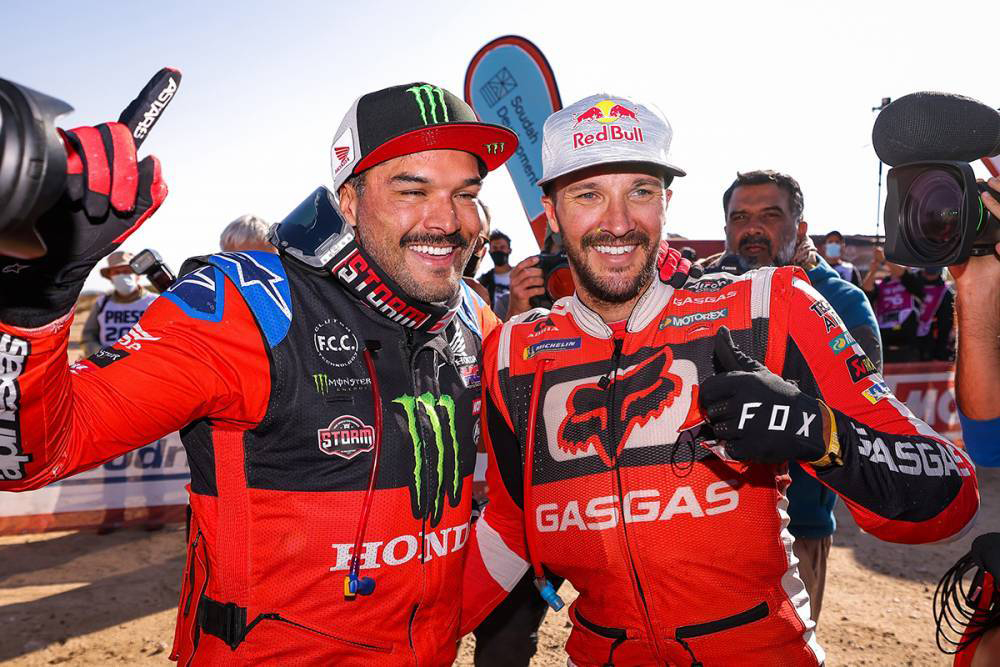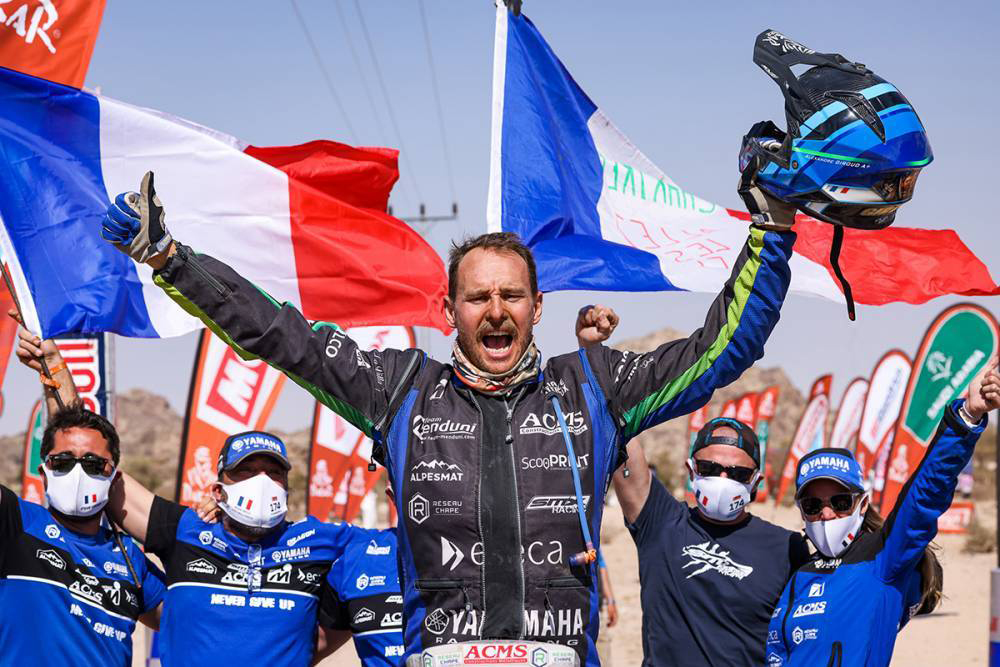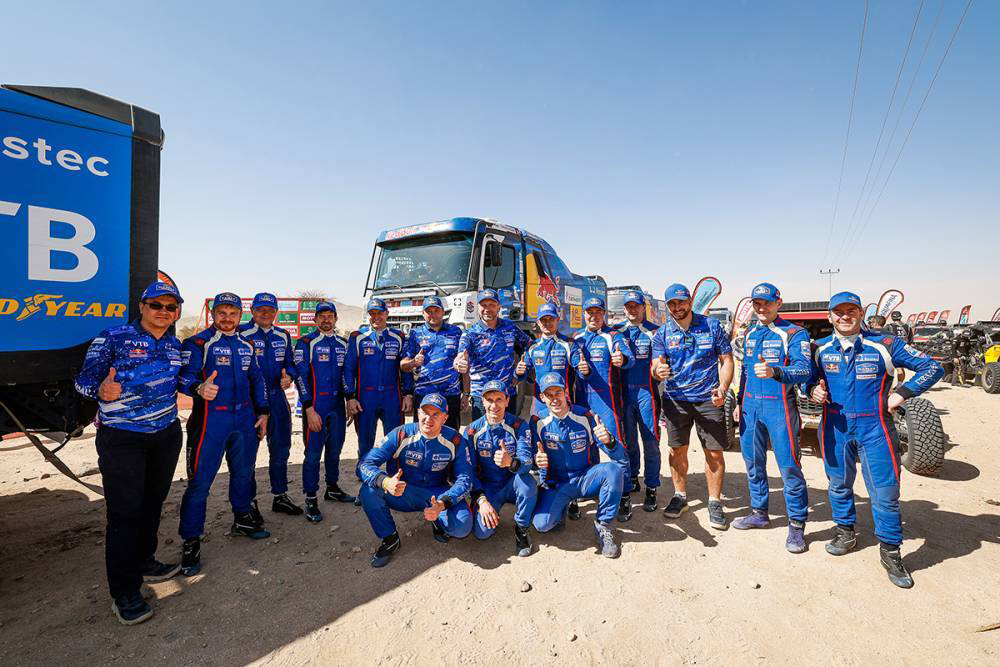
Cars: Al-Attiyah king of the desert
Being the big favourite is a coveted position, but not necessarily a comfortable one. Nasser Al-Attiyah has cracked under the pressure several times before, but this year he and his co-driver Mathieu Baumel put in a masterful performance. The Qatari was eager to seize the lead from the get-go and took the two specials (1A and 1B) that made up the opening stage. Meanwhile, the Audis were already on the back foot, first when Sainz made a catastrophic navigation blunder and then, the next day, when Peterhansel lost one of his rear wheels and had to accept an extremely heavy penalty in order to continue his Dakar adventure. Against this backdrop, the fight for top honours soon came down to a duel between Sébastien Loeb and Al-Attiyah, but the Frenchman faltered in stage 3, when he suffered a broken drive shaft, resulting in a 50-minute deficit by the time the rest day came around. Firmly in command, the man who earned the nickname of “Prince of the Desert” in South America became a king by claiming his fourth Dakar title in the Middle East, next door to his home country, to go with his victories from 2011, 2015 and 2019. Loeb can find solace in the stellar performance of his BRX Hunter, but like in 2017, when he came up short in his duel with “Peter”, he ended up in second place… his least favourite! Yazeed Al-Rajhi inserted himself in the Franco-Qatari battle several times and proved that he is a force to be reckoned with on home turf, claiming his highest finish so far and climbing on the final podium for the first time (third at 1 h 01′13″).
Behind the top 3 that everyone yearns for, Prodrive can be pleased to have Orlando Terranova’s Hunter in fourth place, the best result of his career in a car after fourteen starts. In contrast, the Mini X-raid buggy seems to have been left in the dust by the new generation of T1+ cars, with Jakub Przygoński slipping down two places to sixth. Giniel De Villiers came in fifth to claim his eighteenth top 10 finish. Also in the top 10 was Mathieu Serradori in his Century (ninth). Mattias Ekström’s tenth place overall (see Stat of the day) capped Audi’s impressive performance over the last fortnight.

Motorbikes: Sunderland in Wonderland
To say that the motorbike category was the closest-run race of the 44th Dakar would be an understatement. The 3′27″ between Sam Sunderland and Pablo Quintanilla in Jeddah were the slimmest margin at the top of the leader board since 1994, when Orioli finished 1′13″ ahead of Arcarons! The Englishman went back to his winning ways after a drought stretching back to 2017. Sunderland’s star had seemed to be on the wane. When he did not withdraw from the race, he had to settle for third the following year. To break this vicious cycle, the Englishman first stayed in the shadow of his flamboyant teammate, Daniel Sanders. However, “Chucky”, the man of the first week, was sent home by a stupid crash while exiting the bivouac in Riyadh in the wee hours. Sam already held the overall lead, which he defended for four days without winning any specials. Meanwhile, three other former champions embarked on an impossible mission after flopping in the opening stages: it was 2021 all over again for Price and Brabec, joined by the defending champion, Kevin Benavides, this time round. Only Matthias Walkner, also a previous winner, and Adrien Van Beveren were able to match Sunderland blow for blow. The official GasGas biker delivered the coup de grâce with a win in stage 8. The same old trick once again allowed him to approach the remaining stages with caution and hatch a plan for stage 10. Sunderland and Walkner held back so that they could chase the new leader, Van Beveren, clad in Yamaha blue, in the following special. Pablo Quintanilla also pounced on the opportunity to finish second, matching his 2020 performance.
Young brands such as Sherco and Hero also had their moment in the sun. Ensconced in the top 5 for almost the entire first week, Santolino and his Sherco expected to feature in the fight for glory before the tables turned. Hero and Joaquim Rodrigues bagged their maiden win in stage 3, with a special thought for Paolo Gonçalves. Red once again fluttered in the breeze of the aptly named sea, but it was no longer Honda’s. GasGas avenged the insult to KTM and became the sixth constructor to take the Dakar.
In the Rally2 category for non-professional bikers, 20-year-old Mason Klein was a cut above the rest, finishing ahead of Camille Chapelière and picking up a stage podium along the way. The Frenchman, nineteenth overall, came in three places higher than in his debut. Romain Dumontier, precisely in twenty-second place, rounded out the Rally2 podium.
In the Original by Motul category for bikers without assistance, the 2022 podium was almost the same as last year’s. Lithuanian Arūnas Gelažninkas retained the title, while the battle-hardened Czech Milan Engel was runner-up and Frenchman Benjamin Melot defended his third place.

Quads: Giroud in the name of the father
Lightweight prototypes: “Chaleco” cruises to double

The Russian truckers have never shied away from their status as favourites. They have racked up eighteen victories with six different drivers since the dawn of the 21st century, only bending the knee to Karel Loprais in 2001, Hans Stacey in 2007 and Gerard de Rooy in 2012 and 2016, and extended their hegemony in Saudi Arabia this year. Each of the four men at the wheels of the blue trucks has claimed at least one stage, leaving nothing for the competition. Reigning champion Dmitry Sotnikov defended his title and led a Kamaz 1-2-3-4. He won the rally with 9′58″ to spare over his teammate and four-time Dakar champion Eduard Nikolaev, who took his eighth podium spot in ten starts as a driver. Kamaz had already locked up the top 4 in 2011. Further back, Janus van Kasteren was the best of the rest in fifth place… over an hour behind the last Kamaz.
The proverb “slow and steady wins the race” sums up the SSV race to perfection. The Polish posse won no fewer than nine out of the thirteen specials up for grabs (including 1B). Marek Goczał was the most prolific stage hunter, with six to his name, followed by his brother Michał with two and Aron Domżała with one. Yet not a single one of them will be standing on the final podium. Endurance races like the Dakar require a high level of consistency and learning to walk before you run. The Polish armada ignored this rule at their own peril and paid the price in the shape of subdued performances and mechanical woes. Austin Jones, on the other hand, flew under the radar. The American seemed on the cusp of victory several times but never quite got there, although he did finish on the podium when he needed to turn the tables on opponents such as rookie Rodrigo Luppi de Oliveira. The Brazilian topped the overall before running into mechanical trouble, the same fate that would befall Gerard Farrés, Jones’s teammate at South Racing, in the last special. Although the Spaniard started the stage in command, an electrical problem cost him just enough time for Jones to take the crown by two minutes. Farrés had to settle for second place ahead of a promising rookie, Rokas Baciuška. In the same vein as Jones, the Lithuanian made little noise before bursting onto the scene with a win in stage 10 and another one in the closing special two days later. His consistency propelled him to the third step of the podium in his very first Dakar start.
Two “rookies”, two polar opposites, stole the show in the motorbike category, but it is hard to weigh up their respective performances. Danilo Petrucci was known for his previous career as a MotoGP, with two Grand Prix victories and four top 10 Championship finishes (sixth in 2019) on his list of achievements. One could be forgiven for believing he had only entered the Dakar on a lark, but the Italian proved on the tracks that his conversion was dead serious. Bikers who learn as fast as “Petrux” are hard to come by. There is no other case in the collective memory of the Dakar of a rider who had never taken part in a rally raid before going on to win a stage. The 31-year-old newbie faded after his exploit in stage 5, eventually finishing the rally in 90th place. At the tender age of 20, Mason Klein could already teach Petrucci a thing or two about consistency. The American prodigy turned heads in the Rallye du Maroc and lived up to the expectations. The Agua Dulce-based biker only found out about the Dakar in 2018, when he picked it as a goal. His baptism of fire ended with a podium finish and six top 6 places in stages and ninth place overall… Quite an auspicious start.
STAT OF THE DAY: 4
By claiming stage 3, Carlos Sainz restored Audi to a level not seen since the 1985 Dakar, when the French private team Malardeau fielded three Audi Quattros. His teammates, Mattias Ekström and Stéphane Peterhansel, went on to take a win apiece on behalf of the German constructor. Sainz came back for seconds on the eve of the finish to bring the number of Audi Sport victories in the 2022 edition to four. It must be said that Peterhansel benefited from the lenient provisions of the W2RC regulations, now applicable to the Dakar, to continue the race despite a broken shock absorber in stage 2. At any rate, on its first Dakar outing, the hybrid Audi RS Q e-tron soon became the first car to take a stage win in the newly introduced T1-Ultimate category for vehicles running on alternative fuels. A similarly successful comeback in the 21st century was that of Volkswagen in 2005, when the Germans chalked up five successes and placed two Touaregs in the top 10 with Jutta Kleinschmidt and Bruno Saby, although they did not win the race outright until Giniel De Villiers delivered the goods in 2009. Others went faster, such as Peugeot, which returned in 2015 with its 2008 DKR. The first performance of the brand with the lion ended not with a roar but with a whimper, as its sole representative by the end of the race, Peterhansel, floundered in eleventh place without any stage wins. A top 10 finish with Ekström and four stage wins mean Audi has outdone Peugeot. Looking forward to next year, the smart money says that the brand with the four interlocking rings will solve the RS Q e-tron’s teething problems and enter the rally with even loftier goals than the French maker.
THE MAKINGS OF A CLASSIC
The second edition of the Dakar Classic had a few surprises in store for the numerous specialists who signed up for it. The real shocker was seeing two regularity race newbies come out on top. Serge Mogno and Florent Drulhon were untouchable and finished the race with 399 points. It was almost the bare minimum, an amount equal to the penalties that many competitors incurred day after day, and they achieved it in a very strong field with the likes of the experienced Arnaud and Adeline Euvrard. At 200 points, the winners held the most considerable lead over their direct competitors in the top 10. Specialists Jesús Fuster Pliego and Juan Carlos Ramírez Moure, third in the general standings, paled in comparison, with twice as many points. Fourth overall, the clear winners of the H3 category, Jérôme and Anne Galpin, finished just outside the podium in their Protruck, but their claim to fame was being the only truckers in contention for the places of honour. Sandwiched between four Spanish teams and as many French ones in the top 10, Feryn team proved that an assistance truck can sometimes overtake the vehicle that it follows! Belgians Tom De Leeuw, Cédric Feryn and Bjorn Burgelman came in eighth on board their Mercedes 2635A, fewer than 50 points ahead of the defending champion’s Porsche. Marc Douton, paired with Jérémy Athimon, who served as his mechanic in the inaugural edition, showed that he remains a force to be reckoned with for the 2023 rally. The top 10 featured four Toyota Land Cruisers, including that of the winners, in a performance that echoes Nasser Al-Attiyah’s. Who knows, perhaps in twenty years it will be the turn of the Hilux T1+ to enter the Dakar Classic!
The RacerViews info
By Matt Hancock
We are passionate, dedicated motorsport professionals.
In 2022 you will see us trackside and stage side with exclusive coverage of
- The World Endurance Championship
- The World Rally Championship
- Belgian Rally Championship
- and more!
We aim to bring you interviews and photos you won’t see anywhere else. We don’t aim to break the news, rather we aim to bring the voices of the racers to you and the atmosphere of the event to you at home. Our social media presence on Facebook, Twitter and YouTube bring you more, a holistic experience. We partner with racers and professionals in the industry and give back where we can. If we can help you or you have a story to share, please contact us.



